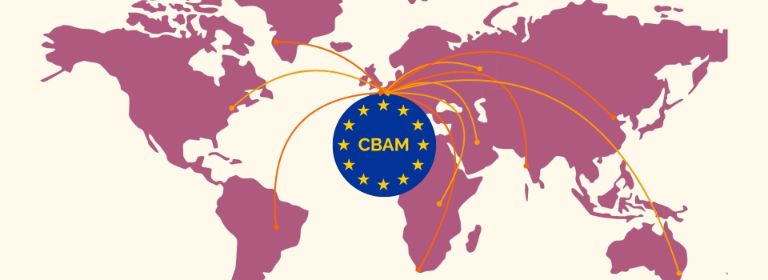Carbon Border Adjustment Mechanism (CBAM)

Measuring your impact beyond your borders
Good Growth Collective helps you navigate the complexities of the EU Carbon Border Adjustment Mechanism (CBAM) with tailored support in carbon reporting, risk management, and long-term decarbonisation.
According to the CBAM, importers are required to monitor, report, and eventually pay a carbon levy on the embedded emissions of carbon-intensive goods such as aluminium, cement, electricity, fertilisers, hydrogen, and iron & steel.
While helping you become compliant, we aim to identify low-carbon supply chain opportunities and reduce your exposure to carbon costs, keeping your business competitive and aligned with the transition to a low-carbon economy.
Curious to know more? Here's how we do it:
- Step 1: Supply chain mapping
- Step 2: Data collection
- Step 3: Reporting
-
Map the supply chain and identify CBAM goods
The first step of the CBAM project is to form a team responsible for compliance and map your company’s supply chain. Creating a clear visualisation of the supply chain will allow you to identify and record imported CBAM goods, and help prepare for the data collection.
-
Collect data and calculate embedded CO2 emissions
After having mapped the supply chain, suppliers will be asked to provide emission data and, if applicable, the carbon price paid in the country of origin. If a supplier is unable to provide the data, automatic calculations can be made in our software tool. This ensures that all necessary information for CBAM compliance is collected efficiently.
-
Report on the carbon footprint and become compliant
After having gathered all the necessary information, we can begin preparing the quarterly CBAM report. Once everything is verified, we can upload all documentation to the EU’s CBAM Declarant portal. As the final step, your company must purchase CBAM certificates to cover the embedded emissions in imported goods.
The advantages of CBAM compliance
Prevent fines and restrictions
Non-compliance with the CBAM can lead to heavy fines and restricted access to the European market. Failure to comply may lead to higher carbon tariffs, additional import costs, and intensified scrutiny from EU regulatory bodies.
Avoid disruptions
Non-compliance with CBAM may lead to shipment delays, customs clearance issues, and increased operational costs. Transparency in carbon reporting strengthens relationships with suppliers and ensures long-term sustainability across your supply chain.
Operational efficiency
Aligning with the EU’s CBAM requirements boosts supply chain transparency and streamlines operations. Companies that optimise their supply chain and develop carbon reduction strategies remain a competitive advantage.
Want to know more about the CBAM?
CBAM is more than a regulatory obligation, it's a bridge to greener borders and global responsibility.
Why is the CBAM important for your business?
The CBAM requires quarterly reporting of embedded emissions for imports of covered goods into the EU. From 2026, importers must purchase CBAM certificates equal to carbon prices from the EU Emission Trading System (ETS), significantly impacting costs. Companies that fail to comply risk supply chain disruptions, penalties, and restricted market access. Early compliance enables the identification of low-carbon suppliers and strategies to reduce future carbon emissions and costs.
Which companies have to comply with the CBAM?
CBAM applies to EU importers of aluminum, cement, electricity, fertilisers, hydrogen, and iron and steel. Impacted sectors include manufacturing, construction, automotive, chemical, and renewable energy companies. Even small import volumes with high carbon emissions require compliance. Companies that use imported steel, aluminium, or cement further downstream could also be required to implement reliable systems to measure and report embedded emissions.
When should you start your CBAM implementation?
Quarterly CBAM reporting has been mandatory since October 2023, with submissions due within one month after each quarter ends. The transitional phase ends in December 2025, after which certificate purchases are required. Supply chain mapping alone can take weeks, while collecting the necessary data requires ongoing engagement. Starting now allows time to source from lower-carbon producers and reduce carbon emissions and costs before the CBAM certificates have to be purchased in 2026.
What software tooling and partners do we use for the CBAM?
We partner with Osapiens for CBAM compliance. The software tracks carbon prices paid in origin countries, calculates embedded emissions using supplier data or default emission factors, and generates quarterly reports ready for the EU’s CBAM Declarant portal. In this way, Osapien's platform automates the compliance process, ensuring accuracy, regulatory alignment, and strategic oversight of emission reduction opportunities.
What makes our SaaS model unique for CBAM compliance?
Our Sustainability as a Service subscription goes beyond your first CBAM compliance project. We help you monitor embedded emissions, prepare quarterly reports, and continuously engage with suppliers. Companies without an in-house team often lack the mechanisms and expertise to collect verified data in line with the CBAM requirements. We not only ensure reports are complete and submitted on time, but provide sourcing advice to reduce carbon emissions and future certificate costs.